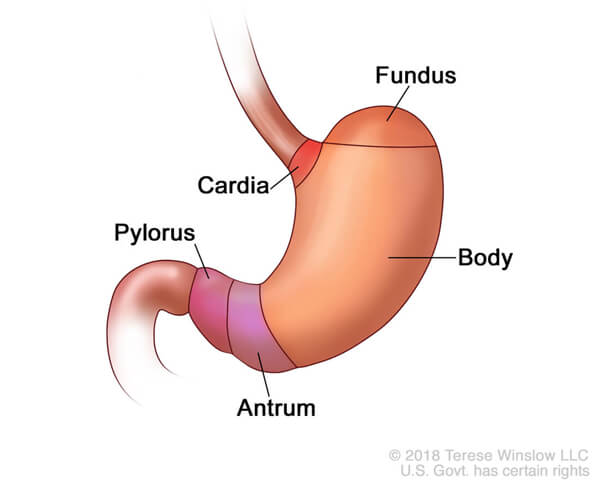Incidence of Cancers of the Lower Stomach Increasing among Younger Americans
January 18, 2018, by NCI Staff
A type of cancer that occurs in the lower stomach has been increasing among some Americans under the age of 50, even though in the general population the incidence of all stomach cancers has been declining for decades, according to a new NCI-led study.
The study tracked the incidence in the United States of cancer of the lower stomach, known as noncardia gastric cancer.
Between 1995 and 2003, the incidence of noncardia gastric cancer in the general population declined by about 2.3% per year, researchers reported January 18 in the Journal of the National Cancer Institute. But when they analyzed the data by birth year, they identified two distinct trends.
Among Americans over age 50, incidence rates fell by 2.6% per year; for those under age 50, however, the rates increased 1.3% per year.
“These results were surprising,” said M. Constanza Camargo, Ph.D., of NCI’s Division of Cancer Epidemiology and Genetics, who led the study. The general decrease in incidence rates for noncardia gastric cancer initially masked the divergence between older and younger individuals, she added.
Risk Factors and Shifting Incidence Rates
Two of the main causes of noncardia gastric cancer are infection by the bacterium Helicobacter pylori and autoimmune gastritis, which occurs when a person’s immune system attacks the lining of the stomach.
The prevalence of H. pylori infection has clearly decreased in the United States over the past century, whereas autoimmune gastritis may have become more common in recent decades.
To assess possible impact of these trends on the incidence of noncardia gastric cancer, the researchers analyzed data from the North American Association of Central Cancer Registries. These registries cover 45 states, or roughly 80% of the US population.
The increased incidence of noncardia gastric cancer among individuals under age 50 was most pronounced among non-Hispanic whites, particularly among women.
There was also a modest increase in incidence among young Hispanic whites during the time period of the study. However, there was no increase among non-Hispanic blacks or other races.
A New Type of Stomach Cancer?
Taken together, the findings suggest that there is “a new [type of] gastric cancer among us,”—one that occurs primarily in the gastric corpus region of the stomach, especially in women younger than age 50, wrote Martin Blaser, M.D., and Yu Chen, M.D., Ph.D., of the New York University School of Medicine, in an accompanying editorial. The corpus is the main body of the stomach.
Drs. Blaser and Chen cited three lines of evidence to support the idea that these tumors represent a new type of stomach cancer: the age-specific effect (increasing incidence among younger generations); the location of the tumors in the stomach (primarily in the gastric corpus and adjacent areas); and the strong sex effect.
“The rapid increases in younger women are especially alarming,” the editorialists wrote. More research is critically needed to truly understand the roots of this cancer, they added.
Increased Incidence: Do Antibiotics Play a Role?
Although the new study was not designed to identify the causes of the increased incidence rates, the study authors noted that trends in incidence rates began to change around the time that antibiotic medications began to see widespread use in the 1950s.
“We are seeing an increasing risk of this cancer in people born after 1950, and that coincides with the introduction of antibiotics,” said Dr. Camargo. “The increase in noncardia gastric cancer rates is more pronounced in females than males, and we know that females take more antibiotics than males.”
The use of antibiotics can disrupt the stomach’s collection of microbes, or microbiome, Dr. Camargo noted. In theory, she added, these changes, including the loss of H. pylori, may lead to autoimmune gastritis, which increases the risk of noncardia gastric cancer.
Noting that more studies are needed to determine the potential effect of antibiotics on the risk of stomach cancer, Dr. Camargo stressed that these drugs save lives and should be used when medically necessary.
Predicting a Reversal of Current Incidence Trends
In addition to gaining a better understanding of the biology of this cancer, researchers need to develop strategies for diagnosing the disease. Gastric cancer is often diagnosed in its later stages, when the disease may be more difficult to treat.
“We need to learn more about the molecular characteristics of these tumors,” said Dr. Camargo. “And we’re trying to identify people who are at high risk of developing noncardia gastric cancer.”
Based on their results, the researchers predict two major changes related to this cancer in the United States. First, around 2025, its incidence will be higher in women than men, which would reverse the current pattern. Second, by 2030, the overall incidence of noncardia gastric cancer will be increasing rather than decreasing.
In their editorial, Drs. Blaser and Chen agreed that such changes were possible and congratulated the researchers “for their keen observations that sound a warning about a growing menace.”























.png)











No hay comentarios:
Publicar un comentario